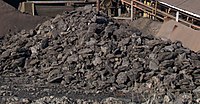
Photo from wikipedia
Surface coal mining activities completely destroy vegetation cover, soil and biodiversity. The aftermaths include huge coal mine spoil dumps, changed topography, drainage and landscape, deteriorated aesthetics and increased pollution load.… Click to show full abstract
Surface coal mining activities completely destroy vegetation cover, soil and biodiversity. The aftermaths include huge coal mine spoil dumps, changed topography, drainage and landscape, deteriorated aesthetics and increased pollution load. These coal mine spoils are characterised by high rock fragments, extremely low water holding capacity, compacted and high bulk density, lack of organic carbon and plant nutrients, low cation exchange capacity, acidic pH and toxic metal contamination, which poses difficulties in reclamation. An array of studies has been focused on the sustainable use of biochar for restoration of degraded agricultural soil by improving the soil physicochemical, nutritional and biological properties. Although a volume of studies has been done on biochar application, its specialised application in reclamation of coal mine spoils is still atypical, also a systematic review on the mechanism by which biochar amends the mine spoil is lacking. This review focuses on i) factors affecting the biochar properties, ii) the mechanism involved in altering the physical, chemical and biological properties by biochar, (iii) remediation of potentially toxic elements in soil and restoration of degraded land using biochar, and, iv) highlighting the important aspects to be considered while using biochar for reclamation of coal mine spoil. Biochar prepared at 450 °C from a lignocellulosic rich biomass can be an alternative for reclamation for coal mine spoil. Review also suggested suitable methodologies for bulk production, application and economics of biochar in coal mine spoil reclamation.
Journal Title: Journal of environmental management
Year Published: 2020
Link to full text (if available)
Share on Social Media: Sign Up to like & get
recommendations!